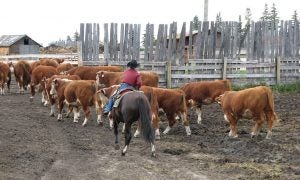People create relationship bonds of varying degrees and strengths in all their interactions. Some, such as with the cashier at the neighborhood grocery store, may be comfortably shallow, while others, like with a co-worker or boss, are much more complicated.
For cow/calf producers who use natural bull service, at times it will be necessary to either buy a first bull or replace an existing one. If poised to look in a new direction, this means working to establish a safe and rewarding bond with a potentially unknown bull seller. Livelihoods and finances are at stake.
Ignore the scrub bull at the local auction barn that no one wanted. Progressive operators should push to the front of the line to benefit from the positives of new genetics.
Look for the cutting edge
Mark Cowan of American Marketing Services says in today’s financial and social climate, data is vital. “If I’m buying a bull, I want to buy one from a seedstock producer that’s on the cutting edge of whatever developments are coming down the line in science and technology. I’m a consumer of information, and with enough of it, I feel I can be accurate in my selection decisions.”
Finding the perfect bull provider can feel like a game of “pin the tail on the donkey,” and a Google search of “cutting edge” likely won’t be much help. But searching genomic testing along with advanced EPD databases should yield some initial possibilities. Cowan says, “Data and trust are extremely vital. It’s important that your seedstock provider has an impeccable database. That includes parent verification and the latest in genomics information. That’s where trust comes in. The buyer needs confidence in the records.”
Visit for the big picture
Cowan sees bull buying as the perfect time to interview bull producers. “Look through their cow herd. Don’t be shy. Ultimately, if you are buying their genetics and retaining replacement heifers from their bulls, their cow herd should give you a snapshot of your future cow herd.”
He warns that one size does not fit all and that it’s important for producers to take stock of what is needed. Those aiming their entire production at the weaned calf market will require a different bull than those breeding heifers for retention or the re-sale market. “For example, someone running a terminal cross program has no reason to buy a maternal bull,” he says. Specific operational goals are required.
Cowan believes it’s imperative for potential bull providers to show interest and initiative in the buying and selling process. “Seedstock producers need to get to know what kind of cattle buyers have. They are the experts and should help their customers in the selection decisions. I would go as far as to say, that includes helping them with breed options. Not every breed is designed to do the same thing, and they may need to bring an outside bull or breed in to take advantage of hybrid vigor.” This may shock cattle people stuck in longstanding ruts, but remember the importance of a provider living on the cutting edge?

Watch for the gut feeling
During field visits, perceptive buyers should get a “gut” feel of trustworthiness and integrity. Can you see yourself doing business with them? If they appear to be on the cutting edge, have an impeccable database they understand and can explain, have readily exposed their private herd to you, and are showing initiative and interest, you’re getting close.
Next, trust and professionalism should go hand in hand. The reality is that bulls can fail, and when they do, buyers need to be dealing with full service genetic providers, not shadowy bull traders. Cross the T’s and dot the I’s. Get guarantees solidly in place. “The time of purchase is the time to discuss these things. Not afterwards. Afterwards tends to cause hard feelings,” Cowan says.
Ask for the non-negotiables
Cowan has two non-negotiable items when purchasing bulls. First, the successful completion of a breeding soundness exam (BSE) by a licenced veterinarian or trained professional within 30 to 60 days of the breeding season. “That’s a responsibility of a seedstock producer and one that should be taken very seriously. You can buy the greatest looking bull in the world, but if he’s shooting blanks, that’s not going to get you anywhere.”
Second is a competent herd health plan. Disease should never be purchased with a bull. Reputable breeders will provide an individual bull’s health record along with vaccination program specifics and dates.
Aim for reality and value
When all the boxes are checked, producers need to be able to spot the difference in bulls aimed solely at winning red ribbons and those built for the real world. Simply put, pampered versus realistically managed. Potential bulls need to be able to move fluently with adequate exercise and should be raised with longevity in mind.
Finally, when a bull-buying producer is confident that they have found the right provider, there is the question of price. Cowan says, “From being in the industry 40 years, a good rule of thumb is the value of five steer calves.” This may seem high at first glance, but not when spread across the bull’s calf crop over a three- to five-year period. “It’s hard to over-estimate the value of a good bull. Not only are you getting the advantage of whatever pounds he might sire in each calf crop, you’re getting the advantage of retained females. It’s an investment that continues to pay dividends.”
When a buyer connects with a seller and establishes a professional and trusting relationship that fits both of their needs and goals, a special bond is created. Cowan knows producers so confident with their sellers, they will simply say, “You know what I need, and you know your bulls better than anybody. Pick me five and send them. That’s the kind of relationship everyone should be building toward.”
Bruce Derksen has worked in Western Canada’s ranching and feedlot industry for over 30 years. He writes about present-day agriculture, hoping to give producers as much up-to-date information and insights about the future of the industry as possible.



